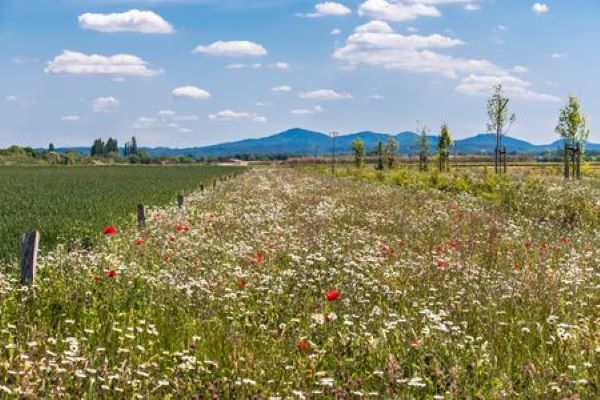Three-year project to maximize ecosystem performance – eight project partners from four E.U. countries – DLG is professional partner and will communicate findings (DLG). As one of eight professional partners of the newly launched international “ConservES” project for research on increasing bioversity in intensive wheat farmland across four E.U. countries, the DLG (German Agricultural Society) will contribute with its biodiversity know-how and additionally lead the communication of project results to the agricultural community.
“The goal of the three-year project is to increase biodiversity in intensive agricultural areas without causing yield losses to farmers,” said Joan Van Baaren, professor at the University of Rennes. “We expect the project to deliver results that can help achieve the significant ecological benefits of floral enrichment for biodiversity as well as ecosystem services on conventionally farmed land,” added Van Baaren.
The benefits of hedgerows and flower strips as habitats for pollinators and natural enemies of pests and weeds will be the focus of the international research project, which is coordinated by the University of Rennes, France, with the professional partners Julius Maximilians University of Würzburg, Germany; Living Lab CLEF, France; Université catholique de Louvain, Belgium; DLG (German Agricultural Society); Crop Research Institute as well as the Association for Innovation and Sustainable Agriculture, both Czech Republic.
With the appropriate project description “Living-lab approach to floral enrichment as a tool to conserve biodiversity and maximising ecosystem services in European agricultural landscapes”, the ConservES project draws on resources from each member.
The project will explore the importance of habitats that exist naturally alongside farmed land, such as hedgerows, or habitats that have been established as “linear semi-natural elements” such as flower strips, serving to improve the abundance and diversity of organisms, pest and weed control, and pollination.
As wheat is the dominant crop produced.in the areas studied – western and northern France, Wallonia, Belgium, southern Germany and western Czech Republic the project will focus on conventional fields of wheat or other small-grain cereals.
The ConservES project is multidisciplinary and based on the combination of four approaches:
- The concept of the real laboratory
- Bioblitz field data collection in each of the five study regions
- Field trials to increase plant species diversity
- Simulations through spatial modeling within the five study regions.
Along a climatic gradient, it is expected that the climatic context will play a major role on the potential of ecosystem services in each area, as temperature is a key effect of climate change.
“Involving local farms is one of the most important activities and a key factor for the success of the project,” says Stephanie Timm, project manager at DLG. “The concept of the real lab is to work with farmers to develop scenarios for expanding diversity within, near and around fields to optimize agroecosystem diversity at the farm and in the countryside generally. The farmers will be involved in biodiversity conservation and ecosystem health,” she adds.
The project’s activities also aim to build an effective network of research and farming practices to communicate the value of ecosystem services and establish the application of the solutions developed beyond the project.
The activities of the project is also expected to build an effective network of research and agricultural practice to communicate the value of ecosystem services and establish the application of the solutions developed beyond the project.
The DLG is active in several biodiversity projects, including “BioMonitor4CAP” (Project number 101081964) funded by the European Union’s Horizon Europe research and innovation program, that aims to develop, evaluate and test affordable and reliable systems for monitoring biodiversity for application on agricultural land. This project focuses on specially protected areas for rare, endangered or vulnerable natural habitats and species of plants or animals.








